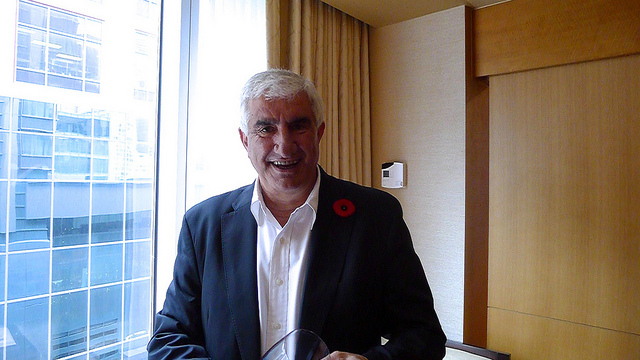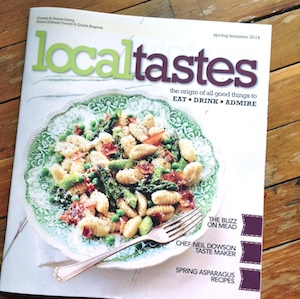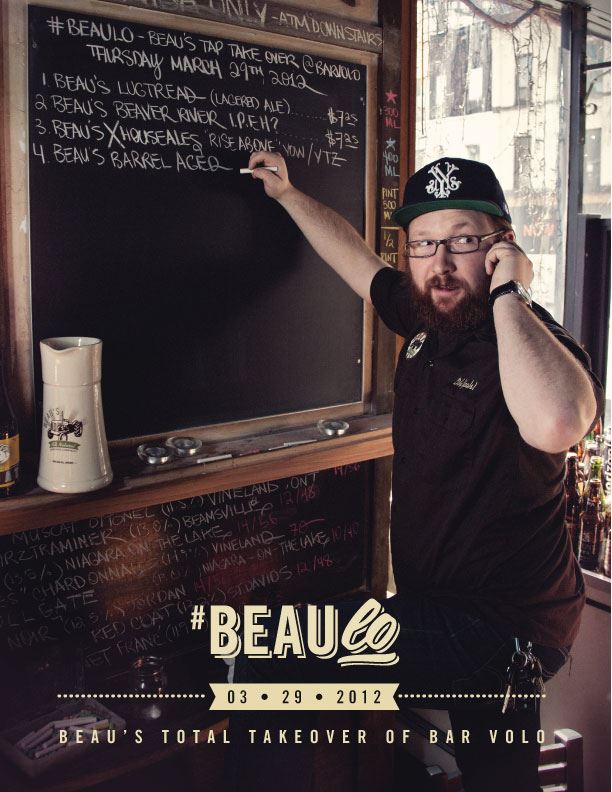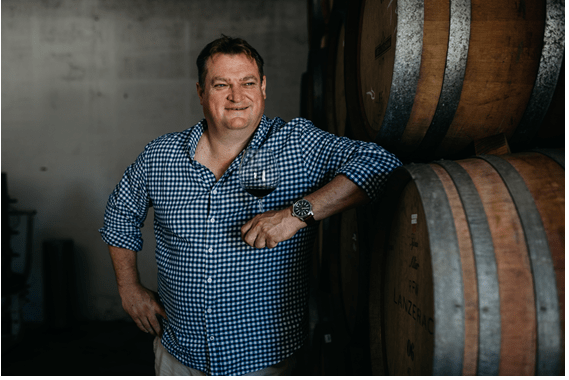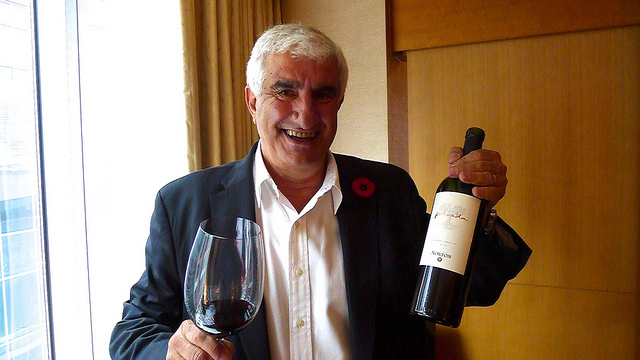
Bodegas Norton’s Chief Winemaker Jorge Riccitelli enjoying a sizable glass of his wine.
A short while ago Good Food Revolution joined Bodega Norton‘s Chief Winemaker Jorge Riccitelli at Toronto’s Ritz Carlton for an intimate tasting of the range of his currently available wines.
Good Food Revolution: Hello Jorge. So how did you find yourself as Chief Winemaker at Bodegas Norton? Where had you been working previously?
Jorge Riccitelli: My beginnings as a winemaker were at Bodega Etchart, Cafayate – Salta. In 1992 I started working in Bodega Norton as the chief winemaker, that in that moment was already purchased by the Swarovski group
GFR: I can distinctly remember Bodegas Norton being one of the first Argentinian wines I saw on a winelist when I moved to Canada 17 years ago. I’m guessing that Canada has always been a good market for you? When did you first begin exporting here?
JR: It’s one of our main markets, the Canadian consumer is a very well informed consumer. The exports started along with the grew of the Argentinean wine export, more than 10 years ago. Nowadays Canada is our 3rd largest market
GFR: So what would you say defines Bodega Norton as a winery?
JR: Quality. Quality in the Wines and in everything that’s is involved with Norton
GFR: And what would you say distinguishes Bodega Norton from the enormous wave of Argentinian wines that we find on our wine store shelves today?
JR: Quality and consistency through the years
GFR: You have a few different ranges of wines at Bodega Norton… let’s start off with the Colección Varietales… now these are your entry level wines, but in my mind show considerable polish considering the low cost per bottle. What is your secret here?
JR: The philosophy on the Colección Varietal tier is fruit. To have wines that are easy to drink and with very appealing colors
GFR: So these Collecióne wines don’t see any oak barrels at all… which brings us to another one of your ranges, the Barrel Select. Now French barrels tend to be extremely expensive… how do you have French barrel influence at this pricepoint without bankrupting the winery?
JR: On the Barrel Select tier, 50% of the wines goes to stainless steel tanks to preserve the fruit. The other 50% goes to oak barrels. In this range we use 2nd and 3rd use of the barrel to give complexity to the wines.
GFR: I have aways been a huge proponent of oak chips and staves for wines at this level, something that is often seen as being a little controversial amongst many of my peers. What are your thoughts? Why do you think that the consumer almost always demands oak influence of some sort when it comes to red wines?
JR: Your concept is not wrong, mainly in what refers to high end wines.
The use of oak is to respond to those consumers that are always looking for more complexity; and this is possible to accomplish with oak barrels or staves.
GFR: And what are your goals with the Barrel Select range? I believe that these wines have proven to be extremely popular in the Canadian market?
JR: My goal is to maintain the quality of the fruit to be able to distinguish the varietals we are presenting and to not to abuse of the over oaked wines. Barrel Select Malbec is the number 1 sku in Canada for Bodega Norton and it is present in every province. We also have listed Barrel Select Sauvignon Blanc and Cabernet Sauvignon that are complement to the malbec.
GFR: Now in North America, Argentinian wines, particularly Malbec have been especially popular over the past five to eight years, and now perhaps the bloom is off the rose, with many associating Argentinian wine with extremely cheap, nondescript plonk. One could also look at the rapid rise and fall of Australian Shiraz, and you cited a similar rise and fall of Tempranillo in France that I was actually unaware of?How do you ensure that Bodega Norton doesn’t find itself a victim of the rapid success of brands such as Fuzion?
JR: The only certainty we have is to keep working with quality; respecting our clients and to have new consumers tasting our Malbecs to make them know our variety
GFR: And do you feel that the reputation of Malbec has been in any way been damaged as “brand”?
JR: No, on the contrary, the Malbec is starting to get recognition on the markets and it will always find pitfalls, but they are easy to recover. Always working with quality, because Malbec is a seductive, unique and distinctive variety.
GFR: I guess that fashions come and go, and the important thing is, as a winery, not to be influenced by such fads?
JR: Malbec is not a fashion, it came to stay. I agree that we need to accompany it with other Argentinean varieties.
GFR: Now Bodegas Norton is a sizeable venture these days. How big is your annual production and how on earth do you maintain such quality regardless of volume?
JR: Bodega Norton is not a huge winery, it’s a medium size winery that produce high end fine wines.
In the exports ranking from Argentina, Bodega Norton is #5 with an average 9 liters FOB retail above the Argentinean average. This means we specialized in premium wines, focusing in the quality, not in the quantity.
GFR: Please tell me a little about your Reserva range… what distinguishes these wines from the Barrel Select bottlings? As I am sure that many of our readers get a little confused with all of these different labels.
JR: The distinctive characteristic on the Reserva range is that they came from selected vines. The use of oak is in 1st and 2nd used barrels, 100% of the wine. Norton Reserva Malbec is one of the main products for Bodega Norton, it’s been receiving great press trough the years, with more that 90pts the past 6 vintages with Wine Spectator and or Wine Enthusiast. The vintage 2011 was awarded as Top 100 (#36) within WS. The winery is very proud to receive these type of recognitions.
GFR: Now these wines have done rather well in competition and have been favoured by many wine writers also. How important is winning medals and getting good scores in magazines to you as a Winemaker? I’m imagining that your Marketing department loves such accolades, but how do you feel about such things yourself?
JR: In these markets influenced mainly for American publications where the consumer is more used to buy wines regarding their scores, if there are good, they are welcome. But this is not our goal, our goal is to be recognized by our consumers that will appreciate our quality and will keep buying them besides the scores.
GFR: Finally we come to your Gernot Langes 2006… made in quite adifferent manner from your other wines… would you mind explaining the process that makes this particular wine so special?
JR: Gernot Langes 2006 represents the ultimate expression of Bodega Norton, and for that reason is named after its owner. It is the result of the dedication of our agronomist and our winemaking team, as well as the centennial of our estate vineyards where the grapes are born that will make this unique Blend of 80% Malbec, 10% Cabernet Sauvignon and 10% Cabernet Franc. This is a unique wine matured in new French oak barrels for 16 months and then in bottle for another 14 months.
GFR: And what would be your ideal food pairing for this wine? a wine of which you are obviously extremely proud (and rightly so).
JR: Rib eye, of course!
GFR: Jorge, thank you so much for joining us at Good Food Revolution today. We look forward to visiting you in Argentina one day in the future.
Many thanks to Maria Julia Cahiza for additional translation.
…

Edinburgh-born/Toronto-based Sommelier, consultant, writer, judge, and educator Jamie Drummond is the Director of Programs/Editor of Good Food Revolution… And he thought that Jorge was such a gentleman.

